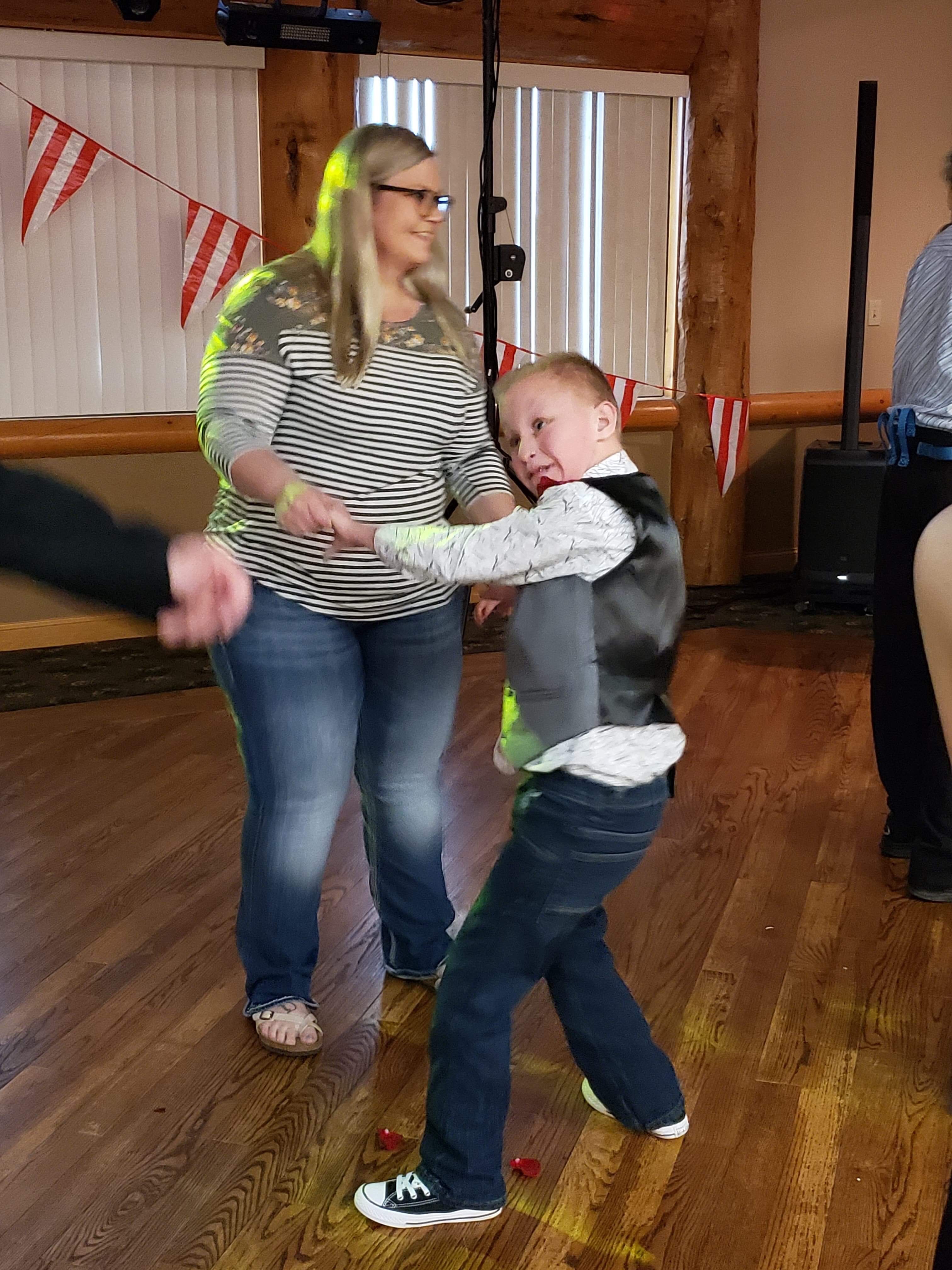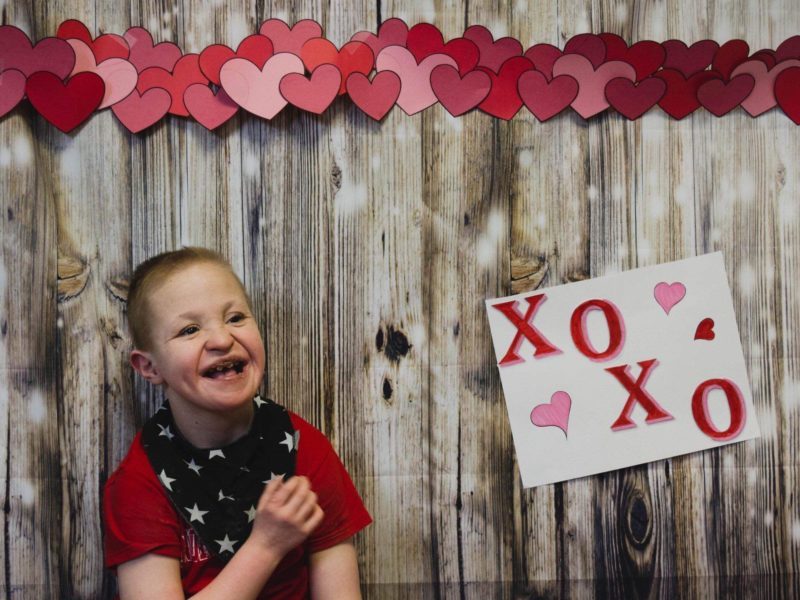Gunner Olesen’s mother and two of his doctors say this 13-year-old grabs onto life with a good-natured gusto that brightens a room or a day, or a week.
Olesen was born to parents Kevin and Leslie Olesen with trisomy 22, a chromosome disorder where there are three copies of chromosome 22 rather than two. On its own, it has made parts of his life a coordinated effort in Sanford Health medical care that follow his every breath.
Those challenges became more complex when he was diagnosed with acute lymphocytic leukemia at age 8.
One did not lead to the other. The first is an all-encompassing disorder that affects mobility and ability to speak and eat. The other was a life-threatening leukemia warranting persistent treatment. Because these two things were sharing time with the same kid, however, they have been inextricably linked.
Thankfully, the long and strenuous attention directed toward the leukemia has been well worth it. Gunner is fast approaching a time when he’ll be able to leave that part of his life behind. To say it has been a hardship, though, is understating his situation.
When her son was 12, Leslie, an RN case manager/clinical care coordinator at Sanford Health of Chamberlain, looked at Gunner’s My Sanford Chart and counted more than 200 times he’d been under medically necessary anesthesia.
Gunner is tough
“At that time he’d had about 50 or 60 surgeries,” Leslie said. “It was for different things. There were things they were looking for — all kinds of things they had to put him to sleep to look at. The kid is tough. We’re strong and he’s tough.”
Enlarge

Submitted photo
Capturing the level of cooperation and determination involved in the Olesens’ life with their son starts with Gunner himself, whose upbeat attitude has made his distinctive challenges a commitment of the heart for his Sanford Health providers.
“Gunner makes everybody smile,” said Dr. Kaye Wagner, who specializes in pediatric oncology and blood disorders at Sanford Children’s and has been part of the team since Gunner was diagnosed with leukemia in 2014. “There is nothing better than his little giggle and when he sings songs for you and claps for himself afterwards. You can’t help but laugh and smile at him.”
There are plenty of others playing significant roles in the lives of Kevin, Leslie and Gunner. They include Leslie’s parents, Dr. Wagner and especially Dr. Travis Sanger, the Olesens’ family doctor in Chamberlain since Gunner was born.
It involves high levels of commitment and communication but the payoff is that it allows the Olesens to spend much of their time in the town where they live rather than traveling the two hours to Sioux Falls so often.
Now Gunner, the kid who couldn’t walk, can walk. And dance. And go for boat rides and be part of all kinds of the stuff active families like to do.
Forming a team
“When Gunner was first diagnosed with leukemia, it was quite frequent that we’d be making trips to Sioux Falls,” Leslie said. “We were on a first-name basis with the people at the front desk and the hospital, the housekeepers and the people at ICU because we were there for so long so many times.”
In Leslie’s capacity as an RN, she was able to assist in the process more than a typical parent. When Gunner progressed through the critical stages, the family was able — with the cooperation of Dr. Wagner and Dr. Sanger — to pare down the time they spent in specialists’ care.
“There were doctors’ appointments back and forth but it doesn’t always work so well with the weather, or times when Gunner was sick and we didn’t want to bring him to an oncology clinic,” Leslie said. “That led to challenges, but that’s where Dr. Wagner and Dr. Sanger really came into play.”
Gunner is now in the “maintenance” phase of his treatment for leukemia. His visits were down to one a month in June with future appointments in Sioux Falls likely further and further apart. His parents are celebrating this for all the reasons one might expect.
“I couldn’t do it without my husband,” Leslie said. “He’s been by my side all the time. We’ve been strong in our relationship together through this whole thing. To have a child born with a disability already and then have leukemia on top of that — it stresses you. It would stress most folks. I couldn’t do it without my parents. I couldn’t do it without the support of the community.”
Covering ground
Sanford Health covers a population of more than two million spread out over 300,000 square miles. It means travel challenges for specialty care is relatively common within the footprint. Making it work involves technologies uncommon a decade ago, but also a unique level of commitment from Gunner’s providers.
On that topic, Leslie begins with the work of their family doctor.
“Dr. Sanger has always been very willing to call any of Gunner’s specialists at Sanford Children’s and tell them what is going on,” Leslie said. “And he’s always willing to take their recommendations and he’s always willing to include me in all those conversations.”
It’s a rapport that has gone well past clinical exchanges of Gunner’s health.
“Obviously Gunner is quite a little fighter — he’s been through challenges that none of us could probably imagine ourselves,” Dr. Sanger said. “Gunner has to take the reins, but boy, they sure have a lot of support for him. I think it’s kind of a miracle that he was born to Leslie and Kevin because I don’t know if this works out the same without extraordinary parents as well.”
A friend forever
From the specialty care side, those exchanges are invaluable. And also necessary.
“Communication is the cornerstone of what we do, both with the families and with the primary care doctors,” Dr. Wagner said. “We have to be a team. That’s the only way this works, especially when they have to travel quite a distance. We need primary care doctors to assess what is going on and what we need to do for treatment. And in this area with the weather, a lot of times they’re doing things for us. They’re the ones who are right there.”
Dr. Sanger has been a loyal conduit between Gunner’s family and all the other providers the 13-year-old has dealt with over the years. Because specialists like Dr. Wagner are part of the same system, the exchange of vital information has been more efficient and more comprehensive than it might be otherwise.
“We have the same chart — we have the same computers, the same language,” Dr. Sanger said. “For instance, when Dr. Wagner does something, I can see that the next day. When she does some labs, it doesn’t end up in a pile of papers that may or may not get looked at as closely as it should. I can pull up his chart and know where to look.”
Gunner’s care will continue to be a cooperative effort that covers both miles and responsibilities. Ultimately the goal will always be to bring the people involved in his life closer together, if not literally, then in their common purpose.
And to hear his mother tell it, he does a pretty good job of that himself.
“Gunner is always smiling, always singing, always fist-pumping and high-fiving,” Leslie said. “He’s a happy kid, very happy. A loving kid, I’d say, he loves to give hugs. Anyone who will sing to him or pay attention to him or talk to him has a friend forever.”
More stories
- Pediatric Medical Home: Making care coordination easier
- Children’s hospitals using genetics to change pediatric care
- South Dakota boy shows how to fight cancer like a kid
…
Posted In Cancer, Chamberlain, Children's, Family Medicine, Specialty Care
